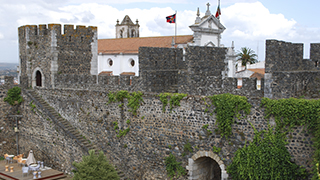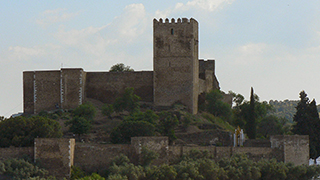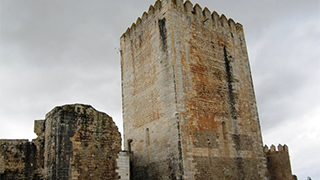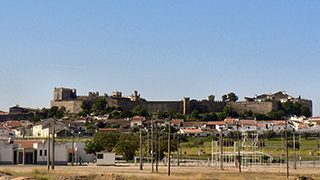Military Defense Line – Baixo Alentejo
In Baixo Alentejo, in the district of Beja, the following towns and city with a significant asset value for the Line:
Alvito
The Castelo de Alvito is in a in a highest point of the plains northwest of Beja, with military and residential function. Some authors classify it as fortified palace. According to documents this region found itself occupied since Roman times and that after its conquest by Portuguese hand, was donated by D. Afonso III to Stephen D. Anes in 1255. Without heirs, D. Estevao Anes left this region, castle and town to the Order of the Trinity. In 1280, D. Dinis granted the charter but Alvito the village progress happens after the implementation of an annual fair in 1296. In 1475, King Afonso V granted the title of Baron of Alvito John Fernandes da Silveira and already 1482, king John II granted the right of this to build a castle. However, this works started only in 1494, in charge of the 2nd Baron of Alvito, D. Diogo Lopes da Silveira, being completed in 1504. With the earthquake of 1755, the castle suffered enough damage and its renovation and restoration began in 1777, at the request of Maria Bárbara de Menezes. During the Liberal Wars in 1834, the castle was attacked and partially damaged, however, obtained restoration work. In 1887, a promise of sale of the castle was signed with usufruct clause to death between the owners D. Jose Wolf da Silveira Quaresma and wife Carolina Augusta D. Duarte and future King Carlos. Before the death of the owners, Don Carlos had been purchased fortified whole. In 1910, Alvito Castle was classified as a National Monument. And with the implementation of the Republic, Manuel II delivered this to the House of Braganza in 1915, that is until today under his protection. From the year 1941, consolidation and reconstruction interventions were performed. When the Carnation Revolution, the castle was taken by Alvito Residents Committee, which to date have promoted adaptation works. Between 1980 and 1981, more interventions were performed. With proper recovery and rehabilitation, Alvito Castle consists of the establishments of the network Pousadas de Portugal.
Beja
The Beja Castle lies northeast of the city, this medieval castle is arranged in a pentagonal plant, flanked by six towers, including the donjon. The construction of this castle and its wall began when D. Afonso III granted the charter to Beja. Already the donjon is associated with the reign of King Dinis, is regarded as the highest tower in Portugal and is for many researchers, the most beautiful tower with a warlike and artistic nature in a unique way. This military architecture set also includes the curtain wall that delimits the old city, which has been preserved until the War of Restoration. The General Directorate of National Buildings and Monuments made several changes in the House of the Governor, in the square of weapons during the 30s, in order to enhance and preserve the fortified whole, including the Castelo de Beja.

Mértola
The Mértola Castle was built in the Christian era, obtaining various transformations and restoration work throughout history. Its main tower was erected in 1292 by order of King João Fernandes, Master of the Order of Santiago and currently houses the museum center and is also a place with excellent conditions for observing the village and the surrounding territory. In 1943, this fortified set was National Monument.

Moura
The Castelo de Moura is in a dominant position on their village at the confluence of Brenhas riverside with the stream of Lavandeira, tributaries of the River Ardila and left of the Guadiana River, is currently in Nature Reserve area. The castle had a defensive function, along with the watchmen of the Fat Head, Head Magra, Puerto Mourao and Albariño. The occupancy Moor dates back to the Iron Age, being occupied successively by Romans, Visigoths and Muslims, which turned out to be the capital of Al-Manijah province, since so arises the need to build a fort, which dates from the century XI until the beginning of the twelfth century, currently there are some traces of this Muslim fortification, including the Tower of Salúquia.
During the time of the Reconquest, the town is both under Portuguese rule as a Muslim, up to the total Portuguese rule in 1232, in the reign of King Dinis. Granted the charter, even during the Muslim occupation, the charter in territory was renovated in 1315, is proceeding well, the reconstruction of the castle, reusing the old walls, in charge of the Order of Avis, who donated a third of the income of church Moura and Serpa. During these works, a line of watchtowers was built, covering the entire Alentejo streak. Currently, the watchman head Magra still persists.
In the fourteenth century, under the reign of Ferdinand, he began a second around the walled village. Passing from hand to hand, the castle had to modernization and strengthening works. Until the War of Restoration, which was erected one abaluartada line, reinforced by ravelins. This fortified set was occupied during the war against Spain, which its walls were damaged, suffering more damage during the 1755 earthquake.
Castle Mouro, along with the ruins of the Convent of Dominican nuns and his Church were classified as Public Interest in 1944. In the 50’s, were carried out intervention works through the General Directorate for National Buildings and Monuments. Until the present day, archaeological and worked recovery polls took place in this fortified whole. In 2002, they were carried out landscape enhancement works in the surroundings of the castle.

Serpa
Its occupation dates back to prehistoric times, and later Romanized, who erected a defensive fortification along the road linking Beja south of Hispania. With the fall of the Roman Empire, Serpa was occupied by Alans, Vandals, Swabians, Visigoths and finally, for Muslims, the fortified. During the Reconquest, the town and castle were under Portuguese rule until an offense Abu Yusuf Yaqub al-Mansur, to the Tagus River in 1191. Later, Sancho II resumed Serpa control and this was delivered to D . Fernando, his brother. After several confrontations and legal disputes and after rectification of the border, under Portuguese rule, Serpa received its charter in 1295 and began the reconstruction of Muslim fortification, taking advantage of the mud walls. To this end, the Avis Order donated a third of the incomes of the churches of Moura and Serpa. Throughout history, this castle was seen figured, modernized and restored. During the Succession Crisis of 1580, the town and the castle fell into Spanish hands and when the Restoration of Independence, they were donated to Prince Peter, in 1641, achieving modernization works and was designed one bastion fortress to defend the village It is materialized in Forte de São Pedro de Serpa, completed in the year 1668.
With the worsening of the war with Spain, the fortified set of Serpa was severely damaged getting ruined. In 1954, the castle set and the walls were classified as National Monument. Past four years, they started aqueduct section of the consolidation works near the Beja Gate and in 1973 began the process of demolition and clearing of new sections of the wall, as well as rehabilitation works of the Balconies Street section and along the Porta de Moura and the plaster of the Clock Tower. In the 1980s, there were more interventions in the castle district. In 2000, there were strong storms in the region collapsed a section of the wall.




